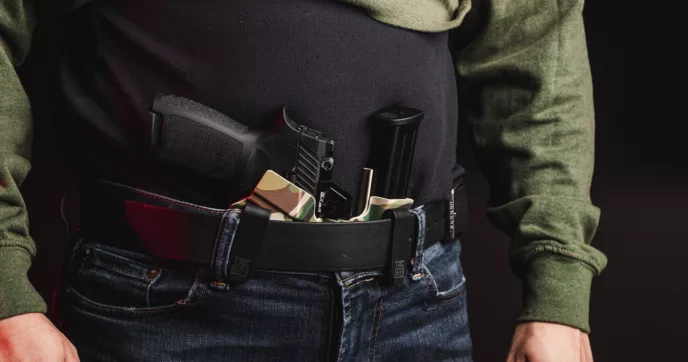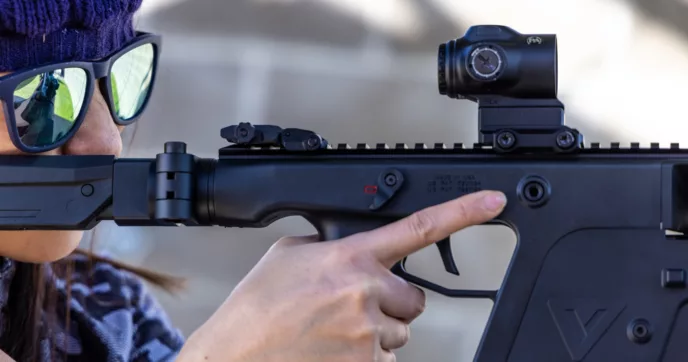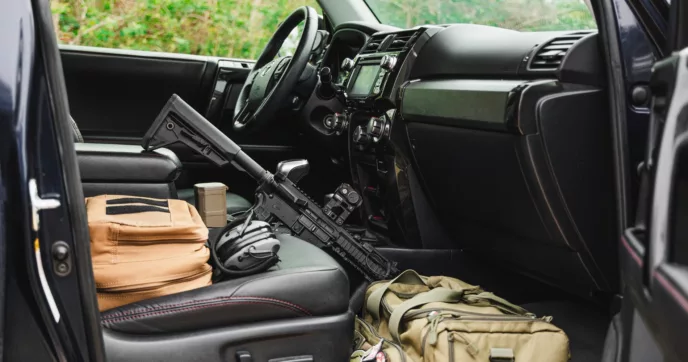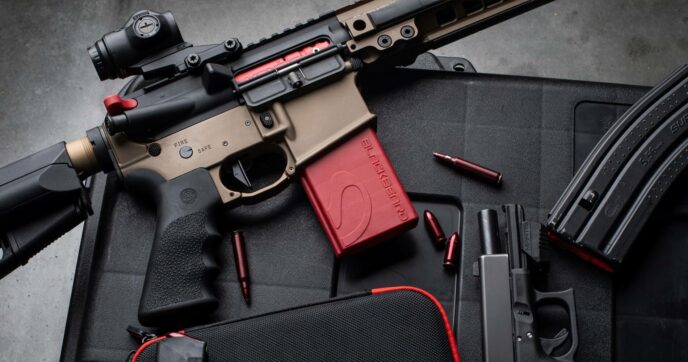Shooting a handgun well is both an art and a science. It requires a great deal of practice and training, a reasonable amount of knowledge, and if you want to be among the best, a bit of talent, too. That all starts with a good stance.
There are other fundamentals too—you certainly won’t be impressing anyone with your groups if your sight alignment or trigger press are subpar—but a proper pistol stance is an essential and all-too-often overlooked piece of the puzzle.
A good pistol shooting stance should position your body to provide you with optimal control over the pistol and allow you to best leverage your bones and muscles for recoil management. In some cases, though, specialty stances are required which typically sacrifice some control to achieve other goals.
Ultimately, the best shooting stance is whichever one allows you to best hit the target, but the vast majority of marksmen will settle on one of the below stances.

A History of Pistol Shooting Stances
In the nascent days of pistol shooting, back when you still had to manually pour your powder and shot down your barrel, a proper pistol stance looked very different from what we are used to today. Marksmen would hold their firearm one-handed, the other hand hanging loosely and uselessly by their side, and stand perpendicular to their target. This was primarily to reduce the shooter’s profile, thereby reducing the chance of him being shot in return.
This perpendicular one-handed stance, sometimes called a dueling stance, would remain more-or-less the default stance until the invention of the repeating pistol. It would receive minor variations, but it wasn’t until double-action revolvers and semi-automatic pistols entered the scene that the common pistol shooting stance started to change in a major way.
These types of firearms brought with them the need to control recoil quickly and efficiently to fire the next shot. A one-handed grip was suboptimal for this, and so two-handed grips became popular, particularly as versions like Jeff Cooper’s Modern Technique and the Weaver Stance pioneered by Jack Weaver took hold.
These techniques both use bladed stances that place the user’s body at an angle to the target, but not one so drastic as to be completely perpendicular, as with earlier stances.
Later, the Isosceles stance would begin to outcompete the Weaver stance, which was the standard for several decades, partially because of its compatibility with optimal body armor positioning.
In modern pistol shooting, the Weaver and Isosceles stances are essentially the only two general-purpose stances still taught and practiced, although other specific stances are sometimes

Weaver Pistol Shooting Stance
The elder of the two modern pistol shooting stances, the Weaver stance is slowly losing popularity to Isosceles but remains a common and effective stance.
The Weaver stance is characterized by a bladed body position in which the user stands at an angle to the target. It’s not unlike a boxer’s stance, where the non-dominant foot is placed slightly forward and the dominant foot is placed rearward. This angles the user’s body, reducing the size of their profile and thereby their chance of being hit, not unlike a dueling pistol stance.
Unlike a dueling stance, this still allows for a strong two-handed grip, which is important for recoil control. In a Weaver stance, the dominant arm is nearly fully extended, but not locked, and flexed taut to help the muscles absorb recoil. The non-dominant arm should be dipped, with the elbow low and close to the body, and should be flexed like the dominant arm. Together, both arms should push against each other in a push-pull grip, with the pistol at the center.
Additionally, in an ideal Weaver stance, the user should be leaned slightly forward at the hips, creating a straight line down the back and rear leg. Both legs should remain slightly bent, never locked, with the forward leg being slightly more bent than the rearward leg, so that most of the user’s weight sits on the forward leg.
This stance creates a strong base for controlling recoil but can be intense to maintain for long periods of time since it relies heavily on tensed muscles to control recoil. However, it does minimize the user’s profile, which some users find important.
One notable variation of the Weaver stance is the Chapman stance. This stance is in most respects identical to the Weaver stance, but has the user fully extend and lock their dominant arm, then dip their head so that they can use their bicep as a cheek weld. Some users, including the stance’s inventor and namesake, Ray Chapman, find this modified stance superior for controlling recoil and quickly acquiring a sight picture.

Isosceles Pistol Shooting Stance
The Isosceles shooting stance is sometimes seen as an evolution of the Weaver stance but is sufficiently different that it can easily be viewed as an independent creation.
In an Isosceles stance, the user stands square to the target, with their feet slightly wider than their shoulders and knees slightly bent. Both arms should be fully extended, but not locked, so that they form a triangle with the torso. As with the Weaver stance, both arms should be tensed, but in an Isosceles stance, flexed muscles are less crucial for controlling recoil, as the stance creates a strong foundation using the body’s skeletal structure.
This stance is very simple to learn and execute, making it popular with beginners. It’s also become the standard shooting stance for most modern police departments. The Weaver stance, with its bladed position, reduces the user’s overall profile but exposes their side.
For users like police officers who wear body armor, this is a significant detriment, as both soft armor and armor plates typically have gaps on the sides. The Isosceles stance causes the user to be a larger target but primarily exposes the armored chest rather than the unarmored area under the armpit.
Lastly, the Isosceles stance is frequently found to be more effective at controlling recoil, particularly with light-recoiling cartridges like 9mm that are fired quickly.

Retention Shooting Stances
A retention stance is exclusively used when a target or threat is in extremely close proximity. In such a scenario, a stance like Isosceles or Weaver where the firearm is fully extended from the body creates a risk that it could be seized. Retention stances are designed to protect the firearm from being taken while still allowing the user to land effective shots at short-range targets.
In a retention stance, no particular foot position is mandated; should a target be within grappling distance, the user is unlikely to have time for footwork. The non-dominant arm should be crossed over the torso, with the hand on the chest or opposite shoulder. This allows the point of the elbow to be used as a block to create space from the threat, as well as keeps the non-dominant arm out of the line of fire.
The dominant, firing arm should be pulled back as far as possible so that the hand is in contact with the torso. The exact positioning of the firing hand will vary, but should generally be near or contacting the torso at either abdomen height or pectoral height. Lastly, the firearm should be held slightly away from the body, to reduce the risk of clothing becoming caught in the slide during reciprocation.
You may note that in this position, it is impossible to utilize the pistol’s sights or even a red dot. For that reason, this position is used solely for targets or defensive applications at very close ranges. Once a few yards of distance can be created between your person and the target, it’s best to transition back to a more traditional stance for accurate fire.

Choosing the Best Pistol Shooting Stance for You
Ultimately, no one stance is better than the other. Many users prefer the Weaver stance for its similarity to traditional rifle shooting stances. This makes it easy to learn and familiar to use for marksmen who have experience with rifles, but not with pistols. Additionally, some users prefer it for its focus on reducing the user’s profile.
Isosceles, on the other hand, is popular with high-level competitors and police officers alike. Police departments tend to favor it for its function with body armor, and both police and competitors appreciate its ability to control rapid fire.
Retention stances, of course, should be used and practiced only in scenarios where other stances are insufficient.
Ultimately, so long as you are sticking to a modern, effective stance like those listed above, you really can’t go wrong.

Conclusion
A good shooting stance is fundamental for effective marksmanship with any firearm, but it’s especially important with a handgun. With a pistol, you have no stock to add stability, so it’s extremely important that your body position be as efficient as possible.
To perfect your shooting stance, there’s no better tool than dry fire training, but for best results, you should consider investing in dry fire training gear such as a Mantis X. With a good stance and diligent training, you’ll be well equipped for carry, competition, or duty.



